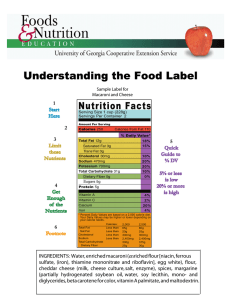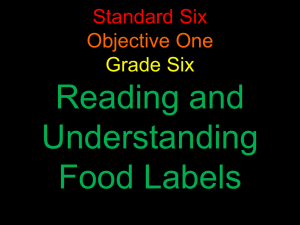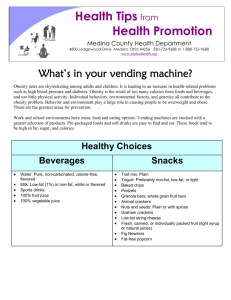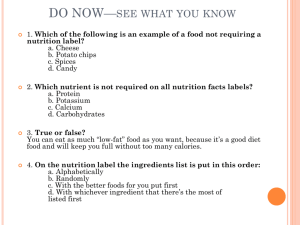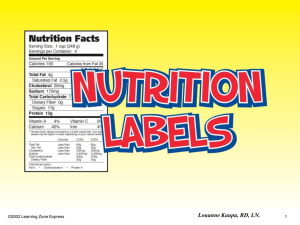3 Knowing Nutritional Facts PowerPoint
advertisement
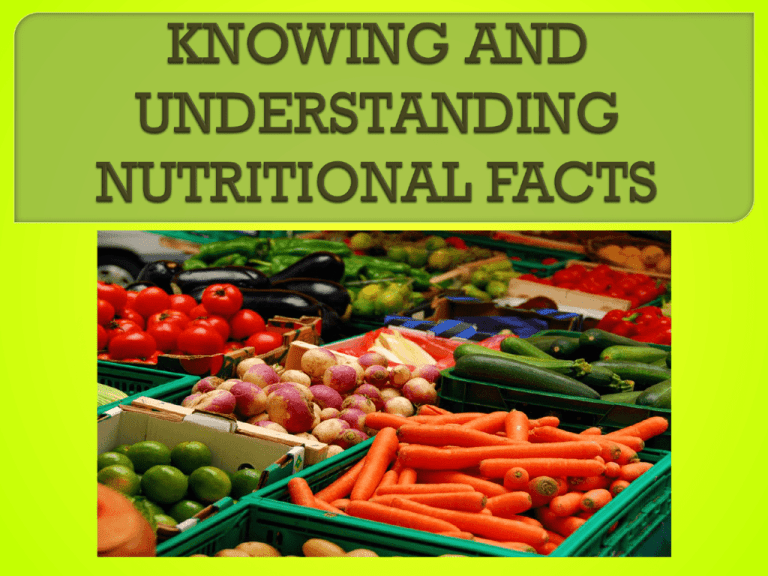
Interpret nutritional facts Identify healthful food choices at fast food restaurants Expand our nutrition vocabulary View a food label and be able to identify the different components of that food label. With a partner please discuss the following questions. Where do you see food labels? What information is provided on a food label? Why are food labels important? List people who would definitely benefit from reading food labels before they buy items. Consumer- Anyone who buys products or services Wise consumers know how to get the facts they need about health products and services. Most packaged foods are required to have food labels Food labels provide nutritional information and list ingredients to help consumers make healthful choices By studying a food label, you can determine the amount of saturated fat, cholesterol, and dietary fiber a serving size of a food or beverage contains It can also help you compare similar foods and beverages EXPLORE THE FOOD LABEL EXAMPLE WITH A PARTNER. Serving size- the amount of food considered to be a portion. This is meant to reflect the amount of food or beverage that most people consume Amount per serving- lists the # of calories in one serving, as well as the # of calories from fat in one serving Percent daily value- the portion of the daily value of a nutrient provided by one serving of a food or beverage. The amount of the nutrient needed each day for optimal health Trans fat- solid fats produced artificially by heating liquid vegetable oils together with metal catalysts and hydrogen They are used to harden veg. oils into shortening and margarine. They appear on food labels because of concern they may increase risk of heart disease and certain cancers. List of nutrients- food labels list the nutrients the food contains and the % daily value for each Daily values / calories footnote- the footnote about percent daily value provides the amount of each nutrient needed each day based on a daily diet of 2,000 and 2,500 calories Vitamins and minerals- vitamin A, vitamin C, Calcium, and Iron are the only vitamins and minerals that must appear on food labels. What are your favorite fast food restaurants? How How often do you eat fast food? can you eat healthy at a fast food restaurant? Consider the ratio of nutrients to calories Limit the amount of fat. Choose steamed, grilled or broiled foods rather than fried foods Choose salad with fat-free dressing Choose fresh vegetables and fruits to get servings from these food groups Drink water instead of sugary soft drinks or high fat milk-shakes Try fish or chicken, especially grilled or broiled Go easy or avoid toppings such as mayonnaise, cheese, bacon, sauces and dressings Beware of words that signal fat and calories such as: buttery, gravy and creamed Add vegetables such as tomatoes and peppers to sandwiches and pizza Avoid oversized portions. Jumbo, supreme, and super sizes may have twice the fat and calories of regular items Skip high calorie desert. Look for lighter choices such as fruit or low fat yogurt. A can of soda contains 150 calories. How many calories would a person save by replacing two sodas a day with 2 bottles of water. (water has 0 calories) How many calories would this person save per week?

